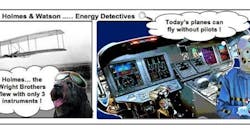Afterword
“If an airplane can fly 8 miles above the earth on 'autopilot,' why can’t a building on the ground do so? The answer is that not only can buildings have 'autopilots' but they should.” – Jim Sinopoly, founder of Smart Buildings (1).
Think about the evolution of airplanes, from Orville Wright’s first flight covering 120 feet in a plane with three gauges to today’s commercial airliners, which have the capability to take off, fly to their destination, and land completely under computer control, without a flight crew.
Compare that with the evolution of the control of energy systems in buildings. With few gauges, operators originally controlled systems manually, relying primarily on their experience. Controls were initially designed to automate some of what they did to keep all of the systems running safely and keep building occupants comfortable.
Until the first big oil embargo in the mid-1970s, at least in the U.S., little thought was given to controlling systems to be energy-efficient. As a result of lines at gasoline stations and other energy “shortages,” the energy conservation profession was founded. Its first tool was the energy audit. Because they could turn equipment off and on, it wasn’t long before vendors started calling temperature controls systems “energy management systems.”
After more than 40 years, we are still a long way behind airplanes. We are back in the days when pilots had to look at the gauges and out the window and use their experience to make the required adjustments to cockpit controls. As Jim says, “We’re not even close to the potential of fully deploying automation in our buildings ... automated buildings will need many additional sensors and metering ... control logic and sequences of operations taking into account a great number of variables.” (1)
Energy Management Systems are still just temperature control systems (TCS). They don’t manage energy any more than the ones of the 1970s did. You can manage and control only what you measure (monitor), and TC systems don’t monitor energy consumption. Don’t believe me?
The fact that energy audits still exist and are the primary tool of the energy establishment and are being mandated by more governmental agencies is proof that so-called energy management systems don’t monitor energy consumption; the required information obviously doesn’t exist.
We have been demonstrating for more than 35 years that when monitored data is used to change the way energy systems are operated and maintained, huge benefits result. Performance and reliability increase, operating and maintenance costs go down and through remote monitoring and fault detection, personnel can spend their time proactively managing energy systems rather than reacting to costly and potentially hazardous failures.
It’s time to unleash the power of information
In 2016, well into the Information Age, nearly every society, business, institution, machine, device, and person in the modern world is continuously connected, sharing huge quantities of information and filling up massive servers. The energy establishment, however, rather than promoting the installation of permanent energy monitoring systems and the use of actual measured data, is still relying on the energy audit and antiquated methods of collecting spot data and “estimating” energy use and savings that haven’t changed since the mid-1970s.
Why not install a permanent energy monitoring system as the first step in every project? It will provide all of the continuous, accurate, and unbiased data required.
Energy audits, benchmarking, collecting spot data, and all of the hours associated with “estimating” energy use and savings as well as commissioning, M&V evaluation, periodic retro-commissioning, and many capital projects can be eliminated. Those savings will more than pay for the cost of the energy monitoring system.
Rather than having a situation in which most individuals in the energy profession spending their time gathering data, filling out forms, and generating reports preparing to save energy, these professionals will have all of the data they need. They can actually become energy managers and fund their own jobs from verified savings. True green jobs can be created. Qualified professionals can spend their time doing something with much greater value and satisfaction.
It’s your choice: Continue to use the antiquated methods promoted by the energy establishment which, according to DOE’s Energy Star Program website, “save an average of 2.4 percent per year,” or get a head start on the future today by installing an energy monitoring system, sensors, metering and software with sophisticated analytics. Embrace proven scientific methods, a continuous improvement process based on actual real-time and historical monitored data and reduce your energy use by 10%, 20%, or more with no benchmarking, energy audits or capital projects.
As in the evolution of airplane autopilot systems, the human intervention will be gradually reduced. The energy monitoring system will eventually be integrated with the temperature control system and the result will be an “autopilot” system that will be able to determine the most efficient operation and control the energy systems to achieve it.
By following the example of airplanes and applying the same standards
for information, control, training, reliability and accountability…….
buildings will be able to fly on “autopilot” too!
(1) Read Jim Sinopoly’s article.
Contact Bill: [email protected]
